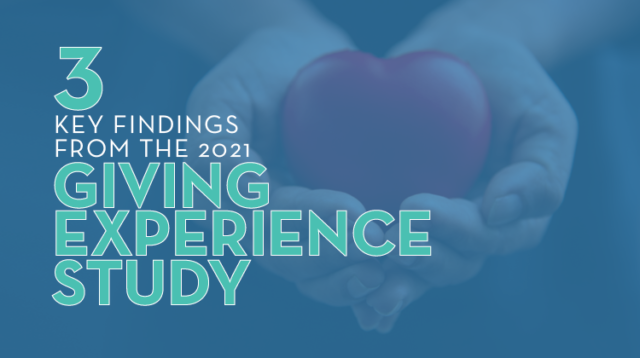3 Key Findings from the 2021 Giving Experience Study

With the busy year-end giving season fast approaching, you might be wondering what your organization can do to maximize donations, encourage recurring giving, and build lasting connections. But you’ve heard every last tip in the book, so what else is there to learn?
In the first half of 2021, OneCause conducted a survey of 1,026 Social Donors to explore how giving has evolved during the pandemic and what lessons we’ve learned from the virtual fundraising pivot. In the 2021 Giving Experience Study, OneCause made several discoveries that will help your nonprofit make data-driven decisions to help strengthen your year-end campaigns.
In this article, we’ll explore three key findings from the Giving Experience Study and explain what they mean for your nonprofit, including:
- Convenience is crucial.
- Younger and more diverse donors are giving.
- Personal connections are most likely to influence donations.
Data can make the difference between good decisions and great ones. Understanding these giving trends will help your nonprofit make smarter choices and forge stronger relationships with your donors. Let’s take a closer look at these findings and the numbers to back them up!
1. Convenience is crucial.
Convenience — in your donation process, event registration, and activity participation — is one of your supporters’ most important values. The number one way to lower the barrier to engagement is to make engaging as easy as possible.
Even if a supporter feels passionate about your cause or organization, they might not engage if your forms are too long, your event sign-up is too confusing, or joining your virtual gala is too difficult. And the data supports it — just take a look at these engagement-related findings in The Giving Experience Study:
- 64% of respondents said they donated because “it was easy to do,” making Ease the top motivator for donations.
- 78% of participants said they liked being able to attend a virtual event from the comfort of their home.
- Nearly half of donors sent their contributions through the nonprofit’s website. Since 2018, website donations have increased by 10%, beating out every other donation channel.
- Social media and text donations saw the highest increase of usage in 2021 out of any other donation channel, showing that engagement from mobile devices should be a top priority.
Many nonprofits are already doing an excellent job of prioritizing convenience. In fact, 83% of donors said it was easy to make donations during their event or campaign. But there’s still room to improve, especially when it comes to engagement during events. Only 59% of participants said it was easy to access live-streamed content and just 60% said it was easy to interact with other participants.
At first glance, these metrics aren’t terrible, but the issues that cause users to feel frustrated are typically easy to resolve. Take the time to walk through the event experience from your participants’ point of view and note potential obstacles to engagement.
An easy experience will demonstrate your nonprofit’s organization skills while showing that you value your donors’ time. Prioritizing convenience can help you increase donor engagement, retention rates, and attendance numbers! Moral of the story: making small changes in your donor’s giving experience can make a BIG impact on your fundraising results.
2. Younger and more diverse donors are giving.
Younger and more diverse donors are giving more often than they used to, and the pandemic has deeply affected their giving behavior. Compared to Generation-X and Boomers, Millennials and Generation-Z were more likely to donate to sustain an organization throughout the financial hardships of the pandemic.
Millennials in particular became more involved in social giving, outpacing other generations in frequency of donations and variety of organizations they contributed to. Members of Generation-Z were the most likely to donate in response to a current issue or need, such as racial inequity, climate change, criminal justice, healthcare, or human rights.
Diverse donors are also giving more than ever before. Hispanic and Black donors have contributed more to nonprofit organizations over the last twelve months. The percentage of Hispanic donors increased by 4% while the percentage of Black donors more than doubled.
You might be thinking: That’s great, but how can my organization connect with these diversifying nonprofit audiences? The data can help you with that too! Take a look at these tips:
- Young people and people of color tend to gravitate towards Giving Days, so market towards them on important donation days. 46% of Gen-Z, 50% of Black donors, and 46% of Hispanic donors contributed during a giving day or month, compared to just 20% of Boomers and 34% of white donors.
- Many young people and people of color value social justice, mental health, and fair working conditions. Prioritize these values within your organization — not just with your external programming but among your employees as well!
- As with all donors, ensure engagement is convenient and easy. Optimizing donation forms, registration, and other touch points for mobile devices is especially important for younger generations.
As new generations grow and audience demographics change, your nonprofit needs to adapt in order to continue to reach and engage new and existing donors.
Connect with younger and more diverse donors by demonstrating your values, making it easy for them to engage, and connecting with them during times when they’re most involved.
3. Personal connections are most likely to influence donations.
Understanding a donor’s motivations can help guide your marketing efforts, branding, initiatives, and events. According to The Giving Experience Study, a donor’s personal relationships motivated their giving more so than any other factor.
Over half of donors said they donated because they wanted to support the person who asked them to donate. 45% said they were motivated to give to help the person or organization fundraising reach their goal.
What does this mean for you? You must prioritize making meaningful relationships with people who will represent your organization and connect you with their networks.
One of the most effective ways you can reach personal networks is through peer-to-peer fundraising. With a peer-to-peer approach, you broaden your network by connecting with people that your organization’s representatives know.
Don’t be afraid to diversify your peer-to-peer efforts! Rather than only using this outreach style for fundraising, use it for other areas that require promotion, like events, awareness campaigns, or volunteering opportunities.
For example, launch an ambassador program to promote events. If you’re hosting a run/walk/ride event, your participants are already 68% more likely to hear about the experience from a friend, so a formalized ambassador program would help you extend this networking even further.
With a well thought out ambassador fundraising strategy, your nonprofit can:
- Engage top supporters before, during, and after your event.
- Connect your event to a larger social audience.
- Add gamification, excitement, and competitions.
- Create new engagement and revenue streams before your event even starts.
- Tap into the giving motivators of Social Donors — their social circles and networks.
However, personal connections aren’t the only thing you should focus on — donors have multiple needs that must be met in order to be satisfied, and needs change as donors become more invested. While a personal connection was the top motivator for new donors, a recurring donor’s top motivation was feeling like their donation made a difference. Adjust your messaging to fit the groups you’re connecting with.
The nonprofit landscape is constantly changing, which is why it’s essential to return to the data when making important decisions. Remember to prioritize convenience, build relationships with younger and more diverse donors, and lean on personal connections where you have them. We hope these findings will help your nonprofit start the new year off right. Good luck!
